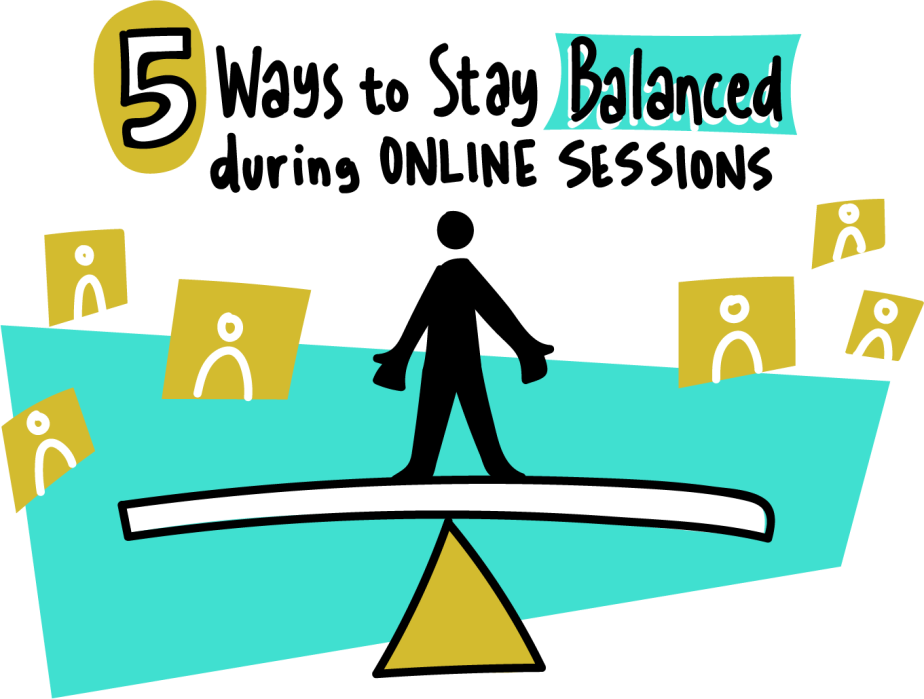“Don’t be satisfied with stories, how things have gone with others. Unfold your own myth.” —Rumi
I found out the hard way that it is no easy task to run an online session. The COVID19 crisis has challenged us in many ways while shifting all our conversations and interactions online. How do I keep it together? Will participants get bored and leave my session? What if I mess up? I gathered together my top 5 key learnings from the various online sessions I’ve experienced lately. I hope they answer some questions you might have about running your online sessions and helps you stay balanced and present during these challenging times.
 #1 Be Fully Present
#1 Be Fully Present
Being fully present is a tough one for me. Before a session it helps to do a bit of “grounding” work. I enjoy breathing exercises the most as it helps clear the mind. Deep inhales, then very long exhales. Taking a moment every now and then in a session to consciously breathe keeps me grounded too. Bonus if you incorporate body movement. Simple stretching, either seated or standing gets everyone feeling present. I find keeping a calm mind is vital. You’ll never know what might pop up. I had an unforeseen technical issue once. I designed a 90 minute session around 3 breakout rooms. Breakout rooms are useful for splitting a large group into smaller groups for deeper learning experiences. For some odd reason the breakout room option was not working so I had to continue without. Can’t keep over 350 participants waiting. I welcomed the technical glitch. Breathe. Calm. Focused. (To be honest, the session turned out better than I had imagined)
 #2 Give Space
#2 Give Space
I try very hard to speak as little as possible. What is the minimum instructions that needs to be shared to get participants engaged? My online sessions tend to be action oriented full of fun activities but I notice I talk too much. (Chris, please shut up and let them get on with it!) During the last online session I ran, at some point participants had to take a moment to reflect on what they had created. I thought it was the perfect opportunity to take out my ukulele and strum a few calming chords to get them into a relaxed state. It helped me shut up and it helped them focus. Silence also works. It gives space to allow digesting and processing time. It’s a great tool that I always have to remind myself to use. Silence. Slow down.
 #3 Small Celebrations
#3 Small Celebrations
This is a new one for me and I find it so useful. Creating moments of mini celebrations keeps the spirits up. Keeps it light. Learning together is a lot of fun, so small celebrations creates a sense of “we’re in this together”. We’re all uplifting each other. We get to see and hear each other. One of my favourite mini-celebration is inviting participants to wave their hands like a bird if they’re ready to “fly” to the next part of the activity. The typical one is “Give me a thumbs-up if you’re ready” but that’s so 1980s! Coming up with small novel ways (even for just a moment) to invite the imagination or even the body to move is a great way to keep everyone in the flow. It’s like small fun check-ins.
 #4 Stay Curious
#4 Stay Curious
I’m always amazed with what participants share. I’m so inspired with their generosity and courage to share their thoughts and feedback. So yes, sometimes I do wish I was a participant instead. Most of my questions come from a place of curiosity. I’m so curious to see the participants perspective. What emotions are arising? What is it that they see? What are they finding challenging? I get caught in the performance mode, but then I have to remind myself to get into a learning mode too. For that I’ve got to stay genuinely curious about their learning as this will help my learning. It’s a learning party!
 #5 Authentic Voice
#5 Authentic Voice
This is going to sound cheesy. Tone of voice is super important when you run an online session. Speaking in a digital space is very different to speaking in a physical space. In a digital space we’re missing the room acoustics and ambient sounds. It doesn’t feel “real”. I get it, we’re trying our best to mimic reality. Sherry Turkle said it best in her book ‘Reclaiming conversation: the power of talk in a digital age’,
Digital promotes a transactional language
The closest we’re going to having an authentic connection is if we speak with an authentic voice. A voice that connects. (Here comes the cheesy bit) I like to speak to participants as-if they were all my brothers and sisters. I find that it activates a friendly voice. And most importantly it invites a sense of care in my voice. I guess what I’m trying to say is that when I’m speaking to my family I’m actually speaking from my heart. I’m trying my best to be as authentic as possible. (Cheesy bit over)
Conclusion
One of the hardest things to let go is our inner perfectionist. We all want to deliver the best online experience and have participants leave the session with a smile on their faces. I like to test my sessions with trusted and supportive friends who would give me constructive feedback. It would also give me the opportunity to shed any fears I may have. And there are plenty of fears. I had to learn to trust the process and trust my participants to make the best decisions for themselves. They own their learnings and not me. And above all, we’ve got to learn to be kinder to our self. After all this is all a learning experience and we’re all in it together.
What strategies do you use to stay balanced during online sessions?



 How good is your script at grabbing audience attention?
How good is your script at grabbing audience attention?